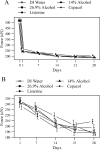The effects of varying alcohol concentrations commonly found in mouth rinses on the force decay of elastomeric chain
- PMID: 22309124
- PMCID: PMC8823131
- DOI: 10.2319/062211-407.1
The effects of varying alcohol concentrations commonly found in mouth rinses on the force decay of elastomeric chain
Abstract
Objective: To test the effect of alcohol on force decay of elastomeric chains in vitro in order to determine if increasing alcohol concentrations results in an increased amount of elastomeric chain force decay.
Materials and methods: A prospective laboratory study was completed to test the effect of alcohol exposure on orthodontic elastomeric chain. A total of 450 specimens were divided into five test groups. Two test groups were each exposed to different alcohol concentrations (14% and 26.9%) and the other two test groups were exposed to different commercially available mouth rinses (Cēpacol -14% alcohol and Listerine - 26.9% alcohol) for 60 seconds twice a day. The control group followed all of the same procedures but was only exposed to deionized (DI) water. Force measurements were taken at six time points (initial, 1 day, 7 days, 14 days, 21 days, and 28 days).
Results: There were no significant differences among groups at the initial time point (P = .52). Statistically significant effects of time on force decay were seen in all groups. All test groups showed significantly more force decay than the control group. Only a few statistically significant differences were observed when comparing force decay among the test groups.
Conclusions: Alcohol causes an increase in force decay of elastomeric chain over time. A concentration dependence of alcohol on force decay of elastomeric chain was not observed.
Figures



Similar articles
-
Comparative Assessment of Force Decay of the Elastomeric Chain With the Use of Various Mouth Rinses in Simulated Oral Environment: An In Vitro Study.J Pharm Bioallied Sci. 2019 May;11(Suppl 2):S269-S273. doi: 10.4103/JPBS.JPBS_9_19. J Pharm Bioallied Sci. 2019. PMID: 31198351 Free PMC article.
-
Effect of mouthwashes on the force decay of polymeric ligature chains used for dental purposes: a systematic review and meta-analysis.BMC Oral Health. 2023 Aug 4;23(1):538. doi: 10.1186/s12903-023-03240-3. BMC Oral Health. 2023. PMID: 37542215 Free PMC article.
-
Force Decay Characteristics of commonly used Elastomeric Chains on Exposure to various Mouth Rinses with different Alcohol Concentration: An in vitro Study.J Contemp Dent Pract. 2017 Sep 1;18(9):813-820. J Contemp Dent Pract. 2017. PMID: 28874647
-
Effect of Bleaching Mouthwash on Force Decay of Orthodontic Elastomeric Chains.J Contemp Dent Pract. 2018 Feb 1;19(2):221-225. doi: 10.5005/jp-journals-10024-2240. J Contemp Dent Pract. 2018. PMID: 29422474
-
Evaluation of force decay rate in orthodontic elastomeric chains in the environment of various mouthwashes: A systematic review.Dent Res J (Isfahan). 2023 Mar 28;20:39. eCollection 2023. Dent Res J (Isfahan). 2023. PMID: 37180681 Free PMC article. Review.
Cited by
-
Comparative Assessment of Force Decay of the Elastomeric Chain With the Use of Various Mouth Rinses in Simulated Oral Environment: An In Vitro Study.J Pharm Bioallied Sci. 2019 May;11(Suppl 2):S269-S273. doi: 10.4103/JPBS.JPBS_9_19. J Pharm Bioallied Sci. 2019. PMID: 31198351 Free PMC article.
-
Effect of mouthwashes on the force decay of polymeric ligature chains used for dental purposes: a systematic review and meta-analysis.BMC Oral Health. 2023 Aug 4;23(1):538. doi: 10.1186/s12903-023-03240-3. BMC Oral Health. 2023. PMID: 37542215 Free PMC article.
-
Influence of Mouthwash Rinsing on the Mechanical Properties of Polymeric Ligature Ties Used for Dental Applications.Polymers (Basel). 2021 Jul 8;13(14):2236. doi: 10.3390/polym13142236. Polymers (Basel). 2021. PMID: 34300994 Free PMC article.
-
The Effects of Zinc-Containing Mouthwashes on the Force Degradation of Orthodontic Elastomeric Chains: An In Vitro Study.Int J Dent. 2022 Apr 29;2022:3557317. doi: 10.1155/2022/3557317. eCollection 2022. Int J Dent. 2022. PMID: 35531573 Free PMC article.
-
Do mouthwashes with and without bleaching agents degrade the force of elastomeric chains?Angle Orthod. 2013 Jul;83(4):712-7. doi: 10.2319/081012-646.1. Epub 2013 Jan 11. Angle Orthod. 2013. PMID: 23311601 Free PMC article.
References
-
- Ash J. L, Nikolai R. J. Relaxation of orthodontic elastomeric chains and modules in vitro and in vivo. J Dent Res. 1978;57:685–690. - PubMed
-
- De Genova D. C, McInnes-Ledoux P, Weinberg R, Shaye R. Force degradation of orthodontic elastomeric chains—a product comparison study. Am J Orthod. 1985;87:377–384. - PubMed
-
- Eliades T, Eliades G, Silikas N, Watts D. C. In vitro degradation of polyurethane orthodontic elastomeric modules. J Oral Rehabil. 2005;32:72–77. - PubMed
-
- Ferriter J. P, Meyers C. E, Jr, Lorton L. The effect of hydrogen ion concentration on the force-degradation rate of orthodontic polyurethane chain elastics. Am J Orthod Dentofacial Orthop. 1990;98:404–410. - PubMed
-
- Kuster R, Ingervall B, Burgin W. Laboratory and intra-oral tests of the degradation of elastic chains. Eur J Orthod. 1986;8:202–208. - PubMed
Publication types
MeSH terms
Substances
LinkOut - more resources
Full Text Sources

